With the tough times raptors and other birds are going through these days two more successfully fledged Red-tailed Hawks is good news indeed.
I’ve been following a Red-tailed Hawk nest for months now but I didn’t want to post any photos of the nest until the chicks had fledged and dispersed. The nest is on a nearly vertical cliff that has exceptionally high contrast in direct sunlight so many of the photos below are hard on the eyes and not very attractive. Please try to look beyond that if you can. These photos are meant primarily as documentation.
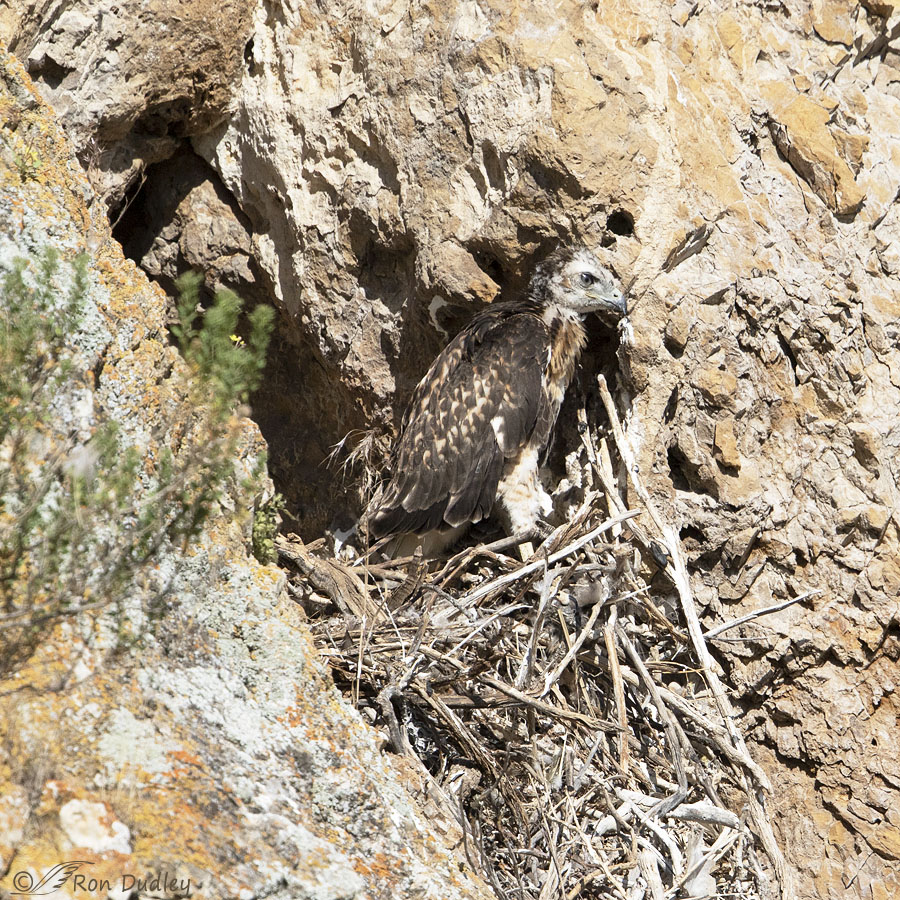
6/28/19
The nest is actually an old raven’s nest built at the entrance to a small alcove or shallow cave in the cliff. The alcove is deep enough that both fledglings could disappear in its depths. And as you’ll see in the photos below the nest looks very different at different angles and in different light.
In this photo taken 14 days ago only one of the youngsters is visible at the top of the nest.
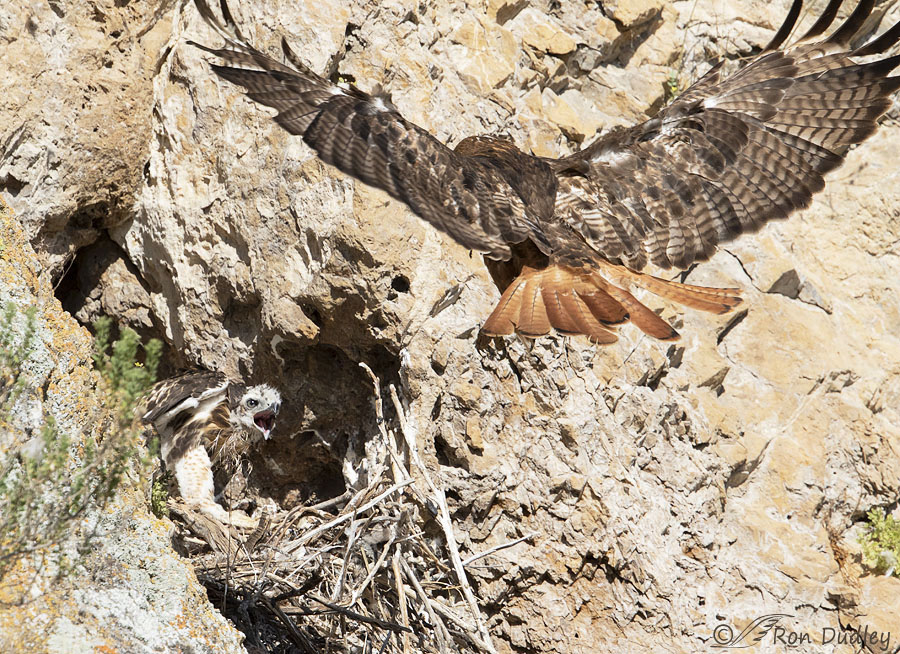
6/28/19
One of the parents was the rufous female I’ve posted photos of in the past. Here we see evidence of some serious molting in her tail. It was her, rather than her mate, who made most of the food deliveries to the nest that I observed.
Things got pretty rambunctious at the nest entrance whenever she delivered a meal so…
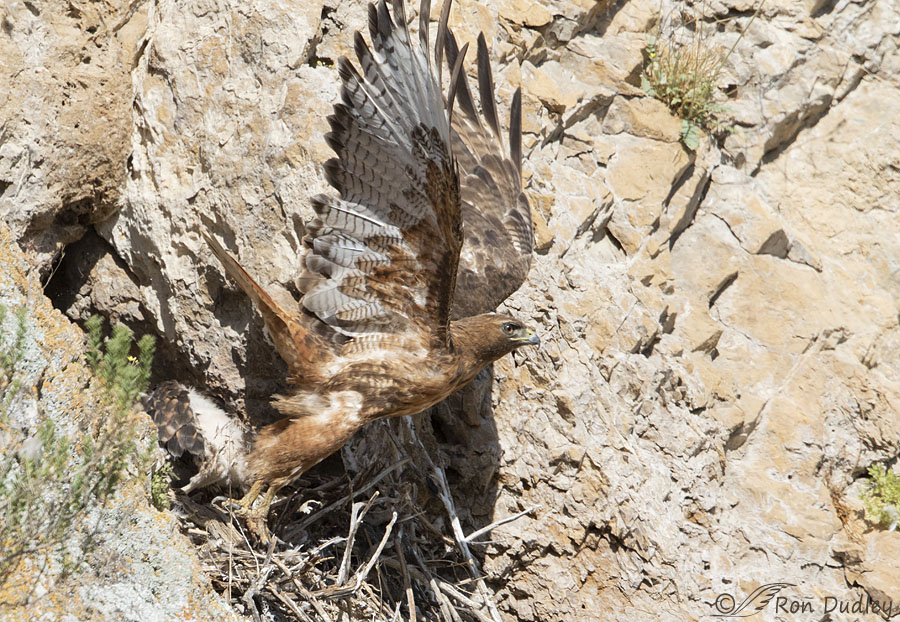
6/28/19
she usually made a quick getaway.
7/02/19
Here we see both chicks five days later. I was shooting at a different angle and the light is very warm this early in the morning.
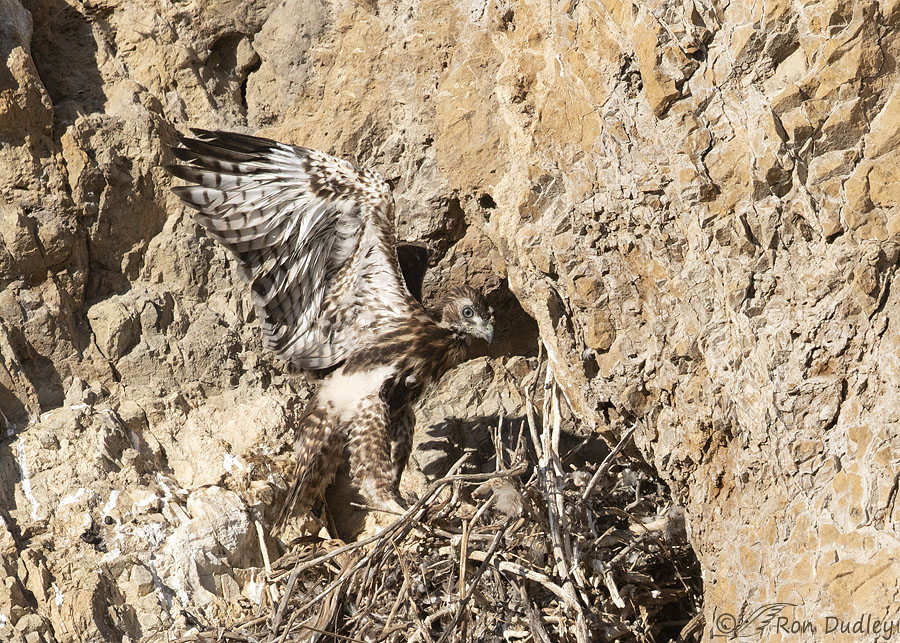
7/02/19
By now the older youngster of the two was exercising its wings fairly often.
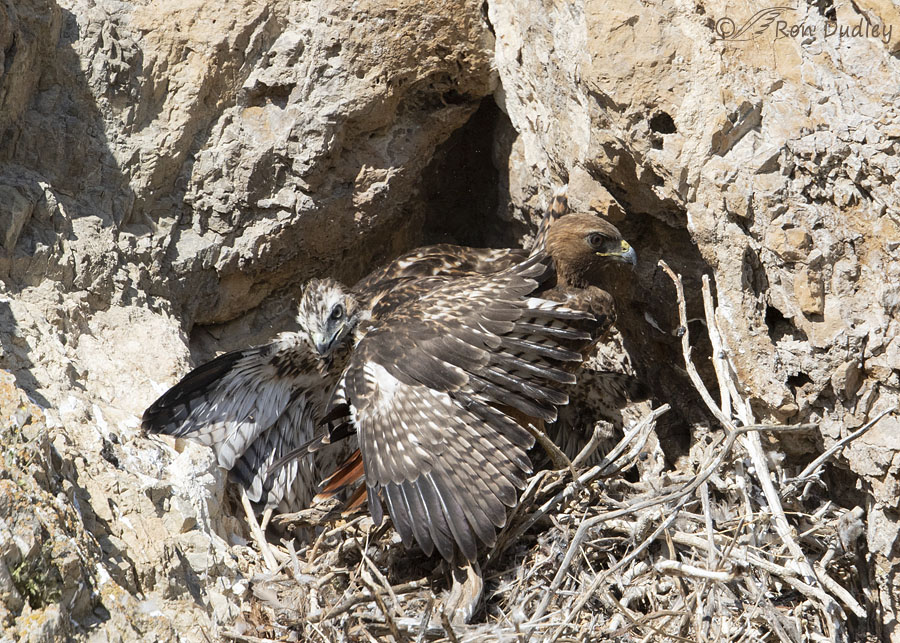
7/02/19
Here the female had just delivered food to the nest and as per usual all hell broke loose as both chicks competed for the meal. I was impressed by her patience with them in that confined space but even her patience had limits so…
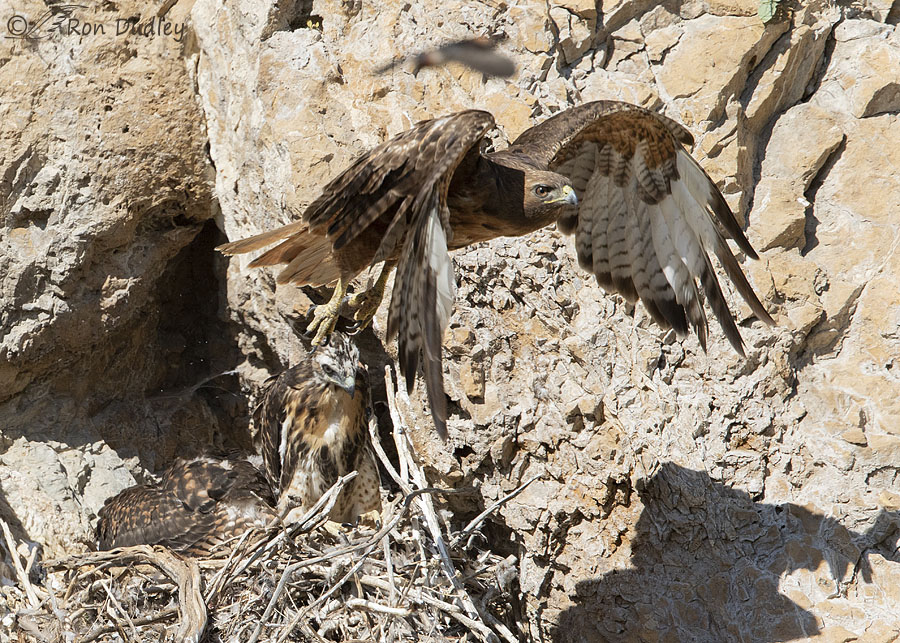
7/02/19
she’d usually beat a quick retreat. Here the chick on the left is mantling the food to protect it from its sibling who actually seems disinterested. Perhaps it wasn’t hungry or maybe it just wasn’t interested in a confrontation.
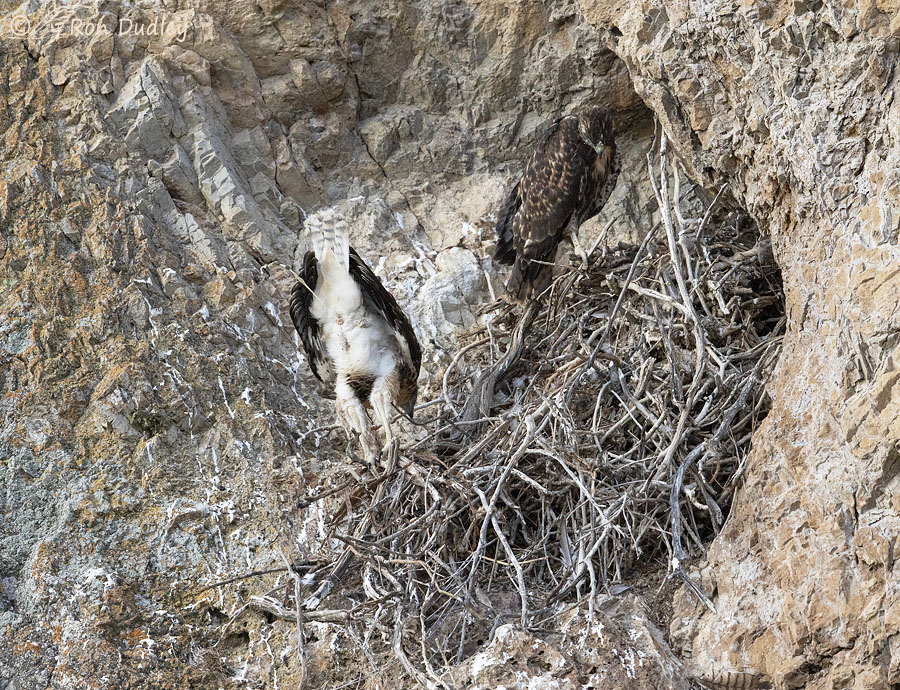
7/04/19
By two days later both youngsters were pretty reliable at aiming their excreta out into the open space in front of the nest. But as evidenced by all of the poop stuck to the cliff on the left side of the nest that hadn’t been the case when they were younger.
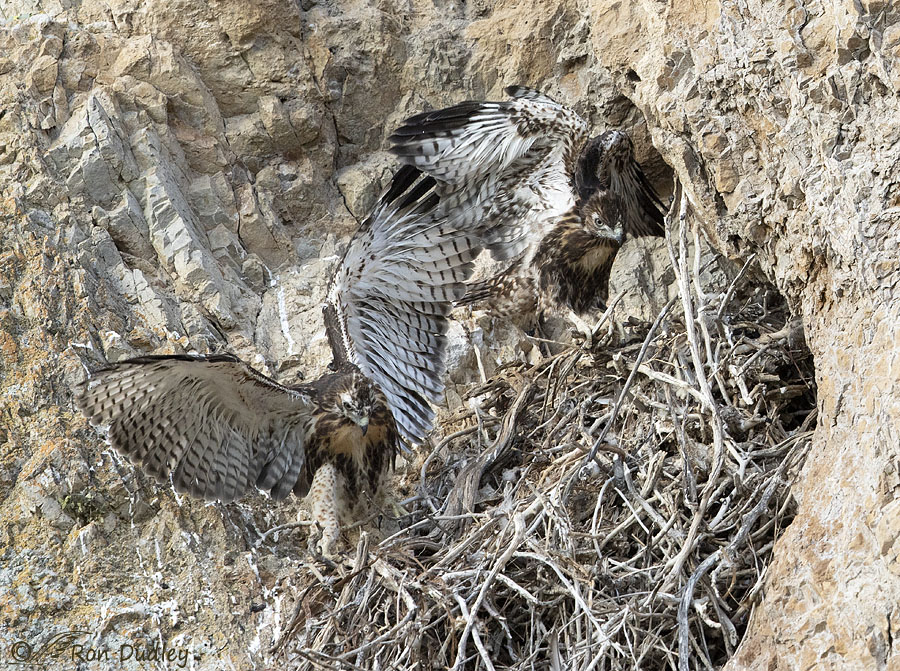
7/04/19
Here the chicks had just exchanged places on the nest and it would always make me a little nervous when they did that because there wasn’t much room up there for two clumsy birds of this size to accomplish it safely. It could be a serious misfortune if one of them fell but thankfully that never happened.
By now I was really anticipating the day of fledging because once they had left the nest I should have many opportunities to photograph them on the ground and low perches as the practiced their flight skills and waited for their parents to deliver food. But for me it’s a two hour drive just to get there so I sure as hell couldn’t make the trip every day.
And then, wouldn’t you know it. Because of overcast morning weather and responsibilities that kept me at home I couldn’t make the trip again until yesterday morning.
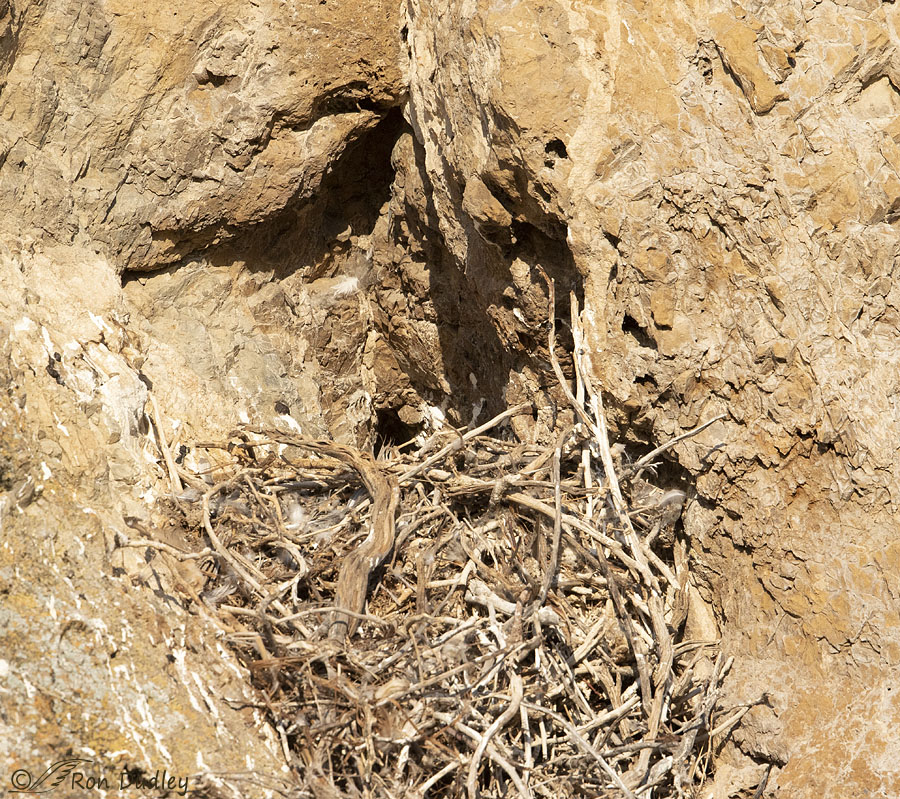
7/10/19
And when I got there the nest was empty. I spent some time searching the area but never found the fledglings or their parents so I suspect they’ve all moved on to other areas where the food resources aren’t so depleted.
I wish them luck. Relatively few young raptors survive even through their first year so they’re going to need all the luck they can get.
Ron
PS – I want to make it clear that I never approached the nest closely and I never got out of my pickup as I was shooting from a road. If I had altered the behavior of these hawks I’d have left the area immediately. I was usually photographing the nest at an effective 1120 mm and these photos have all been cropped significantly. Getting the shot is never worth disturbing nesting birds.


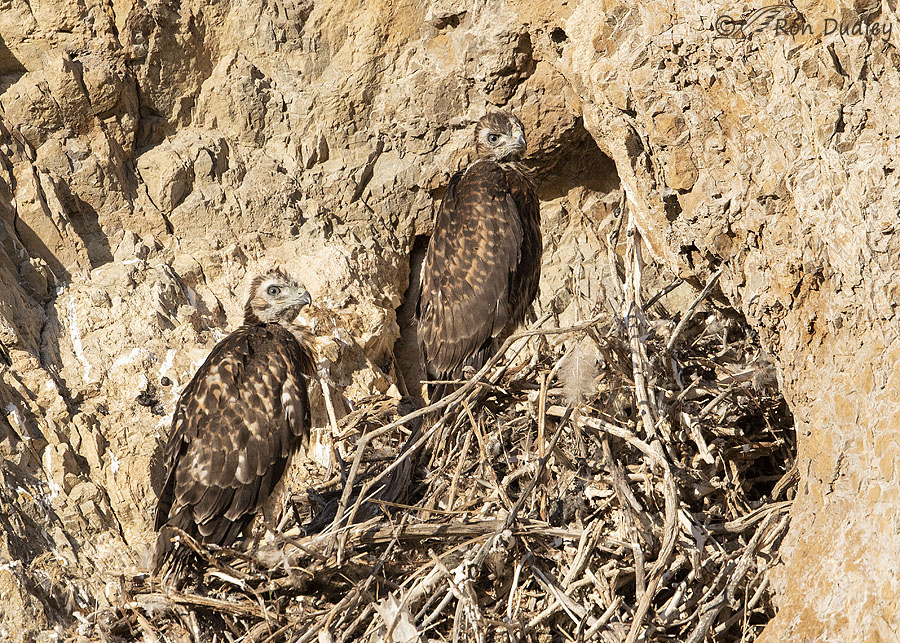
I know I’m late with this one, but sitting has become a challenge, along with typing. ANYWAY,
I truly enjoyed this series–you KNEW I would 🙂 I hope you find that the kiddos are out there, not very far from the nest. They’re not yet capable of going far. Mom and Dad will be feeding them for a while until they figure out how all those flight controls work and get the timing sorted out to catch their own food.
That’s quite some nest for redtails! Guess there weren’t a whole lot of other available options and as usual, boys and girls do what boys and girls do. I guess they ran out of time for house hunting before those hormones took over. LOL!
The rufous female is gorgeous, but you knew I’d say that, too. I’m easy with redtails, raptors, birds and critters in general. They all have a core beauty that eclipses humanity by a mile or several (in my opinion). Interesting that she’s so far along in her molt and I love the banding in her tail that seems to be something that happens in the west more the the east. Mariah is being lazy about it this year and the HAHAs have barely even started!
As usual, thank you for your ethics. I will never understand those humans who don’t have the grace to give wild things room to be wild things. But you really don’t want to get me started on that issue. There would be strings of bad words involved.
Be well my friends!
I enjoyed the series, always good to see how birds cope with space, or lack there of.
Thank you, Jane.
Nice series, I too wish them luck, it’s not easy out there.
Due to the behavior of some of the photographers I have watched this past year and a half, I have been less enthusiastic to go out to photograph wildlife. I was sickened by what I saw this past February at Farmington Bay. It has really effected me, I do not enjoy my hobby anymore. I have gone back to more watching and less shooting, all from a distance. If I see the birds changing behavior I stop what I am doing and move on.
April, I hope that feeling doesn’t last. Don’t let the bastards win. Fight’em. Set an example (as I know you always do). If not for yourself I hope you do it for the birds and other wildlife. If enough of us call them out on their despicable behavior it just might make a significant difference for both the critters and for the ethics of nature photography.
I know it’s late in the day but wanted to say how much I enjoyed this post❤️
It’s never too late for that, Diana. Thanks.
So not only is she beautiful, but that rufous female is an exceptional mother.
I really, really hope the chicks survive. And thrive.
I have my fingers crossed, EC. It’s too bad that we’ll almost surely never know.
Fantastic documentation. One wonders whether they will most resemble mom or dad.
Lyle, I often wonder the same thing, especially when one of he parents is as differently colored as this rufous female is.
Once again my comments didn’t go to the top and got embedded in another. Not sure why.
With respect to the question about feather damage/loss, if a feather is plucked out, new feather growth will immediately be stimulated, but as long as a feather remains in place, it will not be shed and replaced until the normal time of molt. Birds will often try to remove a broken feather. Many times, captive birds (pet parrots, etc.) have the feather on the wings clipped short. This limits their flying ability but prevents new feather from coming in until the annual molt.
Oops. I meant to say wing feathers clipped short. I don’t mean to imply that anyone cuts the actual wing.
Dan, my comments occasionally go in the wrong spot, it is when I am on my iphone. I don’t know why either.
Fascinating stuff about feather development, Dan.
I’m not sure what’s causing the posting problem you describe. Your comment should always go to the top unless you’ve clicked “reply” to someone else’s comment. It looks like that’s what may have happened in your first comment below because it appears as a reply to Kathy’s comment. That’s something I can’t fix on my end for anyone else. But thankfully I CAN fix it when I do it and believe me, it isn’t a rare occurrence for me!
What a great tale to tell, Ron! That nest certainly provides one precarious perch for the youngsters. I’m thrilled that they seem to have fledged successfully. Hopefully, mom is having an easier time finding noshes for her babies in their new location. Looking forward to seeing more from your stash — even if a bit shadowy or blown out. Red Tails is Red Tails. 👍
Thank you for including the P.S. I, too, appreciate your ethics and your inclusion of that oh so important teachable moment.
Marty, it may be that none of the rest of my photos of these youngsters ever see the light of day. The incredibly high contrast of the setting made decent photography almost impossible. I had to process the hell out of some of these photos to make them as presentable as they are and I really don’t like doing that.
Ron. What a great series. Maybe her tail feathers got wrecked getting too close to chicks food fights. Diana
Diana, notice the different lengths of those tail feathers. That’s a sign of molting and regrowth.
I’m with you. Just knowing there are two new Red-tailed Hawks in the world far exceeds any personal satisfaction to be gained from having photographs of them.
Thank you for sharing what I would consider to be important images of these young raptors and their parents. What an experience!
It was indeed. Thanks, Wally.
They surely are TOUGH LOOKIN’ little critters…….so I’m guessing chicks’ eye color changes upon maturation ? They appear to be pale blue/green in the photos ?
Kris, here’s what Cornell’s BNA Online has to say about eye color in red-tails:
“Dark in newly-hatched birds, becoming grayish then buff yellow (53) in juveniles, spectrum yellow (55) during first winter, and slowly grading to hair brown in older hawks.”
I loved seeing this. And I would never ever think you had done anything to disturb them. Your naturalist ethics are one of the reasons I love you and this blog, professor.
Thanks very much, Arwen. I appreciate your confidence in me.
Cool, sorry you didn’t get to see them leave the nest. I don’t know how any of the birds survive. Although the wrens fledged that nested in my pottery studio, and the first batch of Phoebes that nest on our porch made it… the second batch I think one of our Black snakes got.
A bird’s life is a tough life, Jo. No question about it.
Outstanding documentary Ron. Educational,informative, and entertaining. I imagine these little guys/gals can get very anxious and sometimes scared waiting for a parent to return with food. I think you did a remarkable photography job considering the shadows and the sun reflecting off the rock. I share your respect for the birds and their nest. There are some who would do whatever it takes to get the photos regardless of what distress it might cause the hawks.
“Anxious” is one way to describe it, Everett. Frantic is another. Even though I had my back to the direction an adult with food would be approaching from I always knew it was coming just by watching the hyperactive reactions of the chicks.
Very informative series into the life. So much to view and discuss. All your picture angles shows the intricacies of the nest; just looking at all the sizes of those twigs and the weaving process used I find fascinating. I can imagine how you felt photographing them throughout the process…a very special privilege for you. The photo of the youngsters warming in the sun is touching…warming and waiting for food, wondering where mom and dad will return. I can’t begin to guess how many pictures you snapped over the course of your observations this spring with this family. Hopefully you will come across ‘mom’ yet this season and perhaps with great luck next spring. Thanks for sharing.
Thanks, Kathy. I don’t even want to think about how many photos I took of them. Especially since most of them are garbage…
Great series. I very much appreciate your high standards and not publishing this until the birds have fully fledged. They have enough stresses without human interference from others who may show up with less concern for the birds.As you say, the first year of a raptor’s life is a rough one and for most species, up to 70% of the youngsters will not survive. Bald Eagles fair better with approximately a 50% survival rate. So, human interference is a pressure they don’t need. I once discovered a Great Gray Owl nest with owlets only a couple of weeks old. I said nothing about this until many months later and I was then yelled at by a photographer (whose ethics I did NOT approve of. He once used a ladder to get his lens over the top of a Western Wood-Pewee’s nest to get close-ups of the newly hatched chicks). He angrily told me he “needed” a photo of a Great Gray Owl and especially a nest photo and I had no right to keep it a secret. I let him know that if the opportunity occurred again, I would do the same as I did before and let the birds have their space. Not getting a particular photo may be frustrating, but it’s better than harassed wildlife. Many thanks for sharing this series when it is appropriate to do so
Thank you, Dan. Unethical photographers are far too common, including some of those who are very well known in the bird photography field. Here’s an example. Arthur Morris is perhaps the best-known bird photographer of all but his field ethics are deplorable. Anything to get the shot.
Here’s just one example. In this case he photographed a Bald Eagle nest with 3 very young eaglets in it from so close that the cluster of little eaglets filled the frame. By his own admission that photo was taken at just 55 mm. 55 MM FOR CRYING OUT LOUD! And he had a bunch of photo clients with him who were doing the same thing! All those cameras had to be not much more than inches from the eaglets.
And guess where the nest was. It was in Katmai National Park. A National Park for hell’s sake! That photo and all the unethical details can be seen at the following link if you scroll down to the 10th photo.
https://www.birdsasart.com/bn291.htm
So I don’t give a shit if photographers or others think I’m just being selfish when I don’t reveal locations of nesting or roosting birds. They can think what they want but they won’t get that information from me.
Tremendous series on this fine hawk family. The sibling standing by the “mantler” looks like its cooking up a plan to get its share of the chow.
How long does it take to grow back a new tail feather in the molting process?
Sorry they took off before you could get back up there, what a difference a few days makes.
Dave, I don’t know how long it takes. Maybe some of my readers who are rehabbers or falconers will be able to answer your question.
Once the pin feather starts to grow it comes in fast. A few days to a week is my guess from the experience with my birds. Broken feathers just have to wait for a natural molt to fall out.
Thanks for jumping in on this, April.
WOW! What wonderful photos and documentation of the chicks growth! 🙂 🙂 Always amazing to watch them go from clumsy, butt ugly creatures to the magnificent, graceful birds they become. 🙂 Can see the lighting challenges were many not to mention them blending into “the woodwork” so to speak. 😉 Sad to miss them out of the nest finally BUT certainly can’t complain about capturing the series of them getting to that point……
Judy, my initial disappointment at finding them gone yesterday was tempered by the thought of two more red-tails “out there” somewhere. I just hope they both survive to reproduce.
In the past most red-tail nests in this general area have fledged 3 and even 4 youngsters so survival of these two is particularly important.
Great series. Thanks so much!
Thank you, Cindy.
These images are wonderful documentation, completely different than what I hand in my head and very informative.
Many thanks for sharing.
Dick, it was tough shooting at that nest. There was usually a combination of deep shadows and almost blown out whites so exposure was a huge problem. I did what I could with a difficult situation.